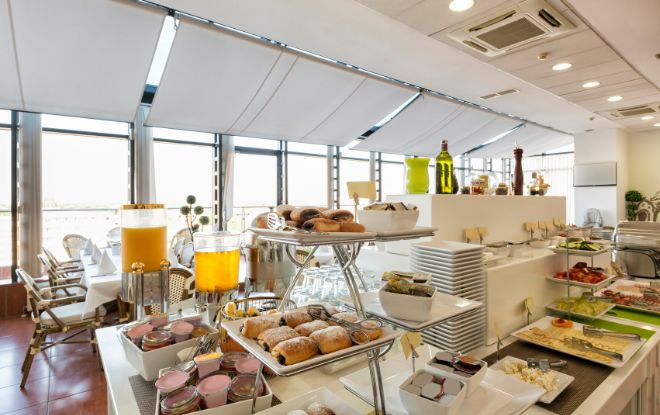If you’re back to traveling for races or training camps, you may be wondering how to handle healthy (and filling) eating in a hotel. Here, we’re digging into our best tips for those who want minimal muss/fuss (beginner), those who are willing to put in a minimal amount of prep work (intermediate) and those who travel often and want to dial in their eating (advanced). Notice that the more advanced you get, the easier it is to keep your food spends lower. However, there are trade-offs, since traveling prepared to cook means traveling with a few key cooking supplies. This is fine if you’re already traveling with a bike bag and have room to spare, but if you’re on a running trip, you may be trying to save $$$ by just flying with a carry-on.
These tips are meant to built on each other, by the way—so if you do travel a ton, still read the beginner advice since the advanced stuff is meant to go on top of that!
Beginner Healthy Hotel Eating for Athletes
You’re going for a few days or a week and have no interest in cooking in your hotel room—but don’t want to go out to eat for every single meal/snack.
Keep it simple
From beginner to advanced, the best thing to do when eating in a hotel while training/racing is to keep things as simple as possible while still staying satisfied and eating relatively healthily. Sticking to a meal plan that stays fairly consistent rather than trying to create new concoctions every day makes shopping and meal prep easier. For instance, rather than alternating between granola/berries/yogurt, oatmeal, or cereal for breakfast, stick to your yogurt and granola. Use it all before you buy a second option. Otherwise, you’re likely to overspend on groceries AND leave a ton of half-eaten food behind for housekeeping to deal with.
Suss out what’s available at the hotel
Does your room have a fridge/microwave? Most hotel websites will show you at least that much, if not the full coffee setup or photo of the breakfast buffet. And often, you won’t need to start from scratch when it comes to the food you’ll need to buy. Many hotels do have some kind of continental breakfast situation offered, though the food available has definitely gone downhill since COVID put pause on all breakfast buffets for a while and many haven’t entirely recovered. But before you go out for every meal or hit the grocery store, look and see what is being served. Often, there are options like cereal or oatmeal, and in some cases, hard boiled eggs, bananas, apples, and toast.
Take advantage of hotel breakfast
Even if you’re planning to supplement the puny buffet options with extras, if you’re on a budget, definitely cruise the buffet and grab what does work for you. You may even realize that while you need to buy your own oatmeal packets, at least you can use the breakfast/coffee nook for your boiling hot water to make said oats. While we don’t suggest *stealing* from the hotel buffet, we will admit to grabbing an extra banana for a ride, or a couple little single serve peanut butters or a few cold cuts (if you’re in Europe) for later.
BYO eating tools
An insulated mug, plastic or glass (microwavable) bowl, fork, spoon and knife are all things that you should pack in addition to your usual water bottle. Having just these basics allows you to DIY a ton of meals in the comfort of your own room, and cuts down on your environmental toll of using a ton of paper and plastic at the breakfast buffet. You can also bring a plastic plate if you have room, but honestly, the bowl is much more useful. We like a Pyrex bowl with a lid so that you can also store leftovers easily—a slightly bigger one like this 4-cup option is ideal so you can fit salads in it as well as cereal.
Figure out your go-to options
I’ve realized that hunger is the enemy of good eating choices. This means doing a bit of homework depending on your location: Look at what’s near the hotel that is easy to access, and consider your best meal options from each place ahead of time. We like Panera and Chipotle (or any burrito bowl type place) for getting quick but reasonable vegetable-and-protein-based dishes. Local restaurants are great too, of course! If you know you want to be eating a little healthier on this trip, one thing I like to do is look at the menus of local spots well ahead of time and ‘pre-decide’ what I’ll get. I’m not looking for the lowest calorie meal, by any means, but I am looking for something that will have vegetables and protein as the stars of the plate whenever possible. Pre-checking menus is a good idea if you know you tend to over-order when you’re hungry. Also do a check for local grocery / convenience / health food stores, just so you know how easy it will be to pick up extra food.
No grocery store option?
If it’s a short trip or you know you won’t have grocery access (i.e you’re on a guided bike tour or a resort, or you don’t have a car), you’ll want to pack some staples. In addition to your ride food, consider what you might want in a day: Oatmeal packets if the hotel doesn’t have them for breakfast, coffee (this is key if you’re a coffee snob!), snacks for post-ride or evening (dark chocolate, whey protein powder), bonus protein sources like Epic Bars or cans/packs of tuna.
Pack your essentials
Always pack your potentially hard-to-find essentials like any specific ride food/drink mix, protein powder, coffee etc. as well as any staples you need that you don’t want to buy in bulk, like a few bags of tea if it’s only a four day trip, or—if you’re like me—a small container of salt. And of course, I always have my travel packs of Athletic Greens AG1, especially since it’s hard to get enough greens on travel days!
Hit a grocery store
Protein and produce are our goals here. It’s usually pretty easy to find carbs on the road, but getting enough fiber? That can be tricky. Assuming you’re not planning to really cook meals in your room (more on that later), you’re looking for ‘extras’ rather than full meals here. This means snacks like apples and peanut butter, bananas, carrots and hummus, pre-hard-boiled eggs, oatmeal (if the hotel doesn’t have any) and single-serve containers of things like soup, tuna or pre-cooked rice that can be heated in the microwave. If you do have a microwave, you can even use your bowl to microwave eggs!
You can also get ‘hotel buffet accoutrements’ to add to the hotel’s options—we often hit the baking supply aisle or snack aisle to get things like walnuts and almonds, coconut flakes, raisins, dried cranberries, chocolate chips, etc. to add to the oatmeal to make a generic packet of oats suddenly into a heftier, more satisfying meal. Plus, you have trail mix as a spare snack!
If you know tend to undereat on trips like this, something heftier like a loaf of whole wheat bread plus peanut butter and jam can be great to have around. Cereal and milk are another easy option that’s available to you if you brought a bowl and spoon.
There’s one caveat: It’s easy to go overboard at a grocery store if you’re only staying somewhere for a few days. Make a list before you go that actually lists out how many meals/snacks you plan to eat in your room, and err on the side of being a little light on snacks versus having extra, unless you’re somewhere so remote that restocking will be difficult.
Intermediate Healthy Hotel Eating for Athletes
You’re going for a little longer and planning to eat some meals in your hotel room to save money and/or increase nutritional value. This means getting smart about what you’re packing, and dialing in a fast in-room meal that can be made in a ton of different ways.
BYOKettle
You can often check with a hotel before you go to see what they provide in every room. Some hotels are opting for kettles over coffee makers, and if you get a room like this, you’re in luck since now you can make your own coffee, tea, oatmeal and even—if you’re very, very careful—eggs. I love these collapsible travel kettles for not taking up a ton of space in your bag, but if you have a regular plastic (not fancy) electric kettle at home, you can always stuff it with your ride food and pack it with your bike.
BYO Coffee Tools
If you’re a coffee snob and you’re bringing a kettle, you’ll want to bring your own method of brewing coffee as well. We like a pourover, especially one like this that doesn’t require a paper filter. This is a must if you’re in a hotel that doesn’t serve breakfast, or it serves breakfast later than will work for you (which is often the case for triathletes, endurance cyclists or runners since start times are often early!).
Talk to management
If you do have an early race and you’re hoping to eat at the hotel, talk to management when you get there. Often, they’re more than happy to find a way to accommodate you—especially if it’s a local race and there are multiple racers staying there.
Dedicate a space
Designate a desk or table in your room as your food storage/meal prep area and keep it clean.
Hit a grocery store
Now, we’re thinking a bit more about eating meals in our room in addition to building out our snack options. You also may want to beef up your breakfast options by adding Greek yogurt, berries and granola—great as a quick snack or meal and easy to eat/store in a hotel room.
For dinner/lunch: We love the salad/rice bowl in situations like this. Depending on how much work you’re doing that day, you can start with a base of pre-made rice or just a lettuce mix, then add on your veggies, proteins and toppers. (We have a whole post on this right here, including the most cost-effective ingredients.)
Pro tip: Unless you pack a can opener, double check that any cans you do buy have a pull tab to open them!
BYO Chef’s Knife
If you’re packing a bike bag/checking a bag, bring a chef’s knife with you. DO NOT do this if you have a carryon only! But having one of these makes making the aforementioned salads a whole lot easier, and lets you get a bit more complex with your hotel room cuisine options.
Advanced Healthy Hotel Eating for Athletes
Think about what a normal day of optimal eating looks like for you. Now, think about what tools you need in order to emulate that at a hotel. These ideas are bit more focused on long-term travel/someone who spends a good portion of the season on the road and really wants to dial in nutrition.
BYO Tiny Slow Cooker or Small Blender
OK, this is definitely not for someone going for a single week. But if you’re planning to be at a hotel for more than a week, or you travel so often that you feel like you live in hotels, having a small slow cooker or a tiny blender makes it much easier to stay on top of good nutrition. Salads can get a bit old, but a small slow cooker makes it easy to make full-on meals, from chilis to chicken dishes to pretty much anything that includes a protein, carb and vegetable. And a small blender makes it super easy to make a recovery shake with berries, frozen bananas, ice from the ice machine, yogurt, protein powder, peanut butter, all that fun stuff.
One caveat: Put your slow cooker near a window and crack the window while it’s on. Otherwise, you’re going to be sleeping with your chili-scented pillows.
Divide and conquer
If you’re traveling with other people, you can really have a great situation because you can combine tools. One person can bring a blender, the other brings the kettle, etc. And it’s easy to make meals if one person is making the rice, the other is chopping the veggies and another is prepping the protein.
Hit a grocery store
When you have all the supplies, it’s easy to overload your grocery cart. But again, unless you’re not able to get back to the store easily, opt for making a second trip rather than going hard on Day 1 only to realize by Day 4 that there’s a great cheap local taco truck you want to go to most nights. In addition to the aforementioned grocery options, though, you can start to take advantage of the more labor intensive, budget-friendly things like using ground beef or chicken in the slow cooker with canned beans and rice. You can also store frozen fruit for the blender in your freezer if you have one, or get frozen fruit/veg the day you need it and drop it in the blender or slow cooker right away. By the time you’re thinking about advanced cooking options, you’ll need to start thinking about cooking essentials like a small bottle of olive oil or packets of spices. We try to either grab one spice that we’ll primarily use (like Trader Joe’s Chili Lime) and are likely to finish in that stay, or we get single-use packets. Avoid buying full bottles of spice for just one meal!
Leave a tip for housekeeping
If you’re cooking up a storm in your room, it’s likely going to smell like it and look like it, and the cleaners who’ve been taking your trash have been working much harder on your room than they normally would have to. Do them a solid by keeping things tidy, even leaving your garbage bag tied and at the door for them when possible. And leave a tip.











